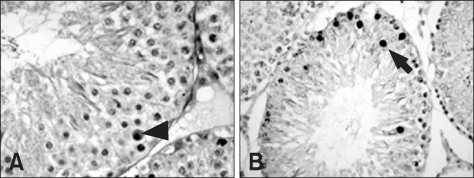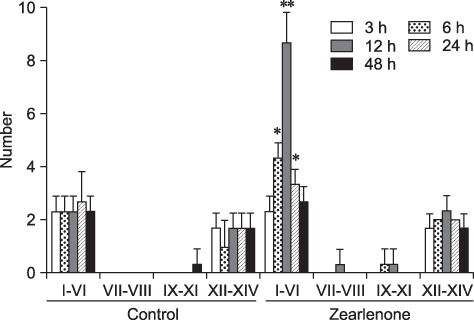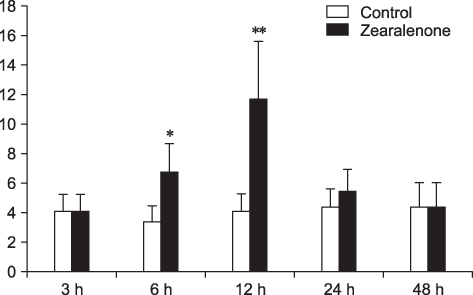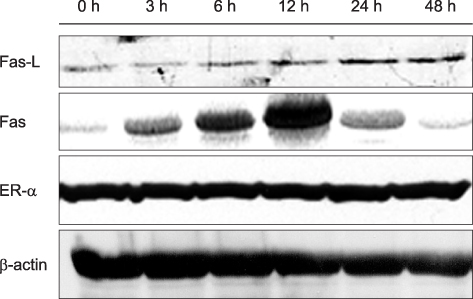J Vet Sci.
2010 Jun;11(2):115-119. 10.4142/jvs.2010.11.2.115.
Involvement of the Fas and Fas ligand in testicular germ cell apoptosis by zearalenone in rat
- Affiliations
-
- 1College of Veterinary Medicine, Jeju National University, Jeju 690-756, Korea.
- 2Research Institute of Veterinary Medicine and College of Veterinary Medicine, Chungnam National University, Daejeon 305-764, Korea. hyson@cnu.ac.kr
- KMID: 1110857
- DOI: http://doi.org/10.4142/jvs.2010.11.2.115
Abstract
- Zearalenone (ZEA), a nonsteroidal estrogenic mycotoxin, is known to cause testicular toxicity in animals. In the present study, the effects of ZEA on spermatogenesis and possible mechanisms involved in germ cell injury were examined in rats. Ten-week-old Sprague-Dawley rats were treated with 5 mg/kg i.p. of ZEA and euthanized 3, 6, 12, 24 or 48 h after treatment. Histopathologically, spermatogonia and spermatocytes were found to be affected selectively. They were TUNEL-positive and found to be primarily in spermatogenic stages I-VI tubules from 6 h after dosing, increasing gradually until 12 h and then gradually decreasing. Western blot analysis revealed an increase in Fas and Fas ligand (Fas-L) protein levels in the ZEA-treated rats. However, the estrogen receptor (ER)alpha expression was not changed during the study. Collectively, our data suggest that acute exposure of ZEA induces apoptosis in germ cells of male rats and that this toxicity of ZEA is partially mediated through modulation of Fas and Fas-L systems, though ERalpha may not play a significant role.
Keyword
MeSH Terms
-
Animals
Antigens, CD95/*immunology
Apoptosis/*drug effects/immunology
Estrogens, Non-Steroidal/*toxicity
Fas Ligand Protein/*immunology
Histocytochemistry
Immunoblotting
In Situ Nick-End Labeling
Male
Random Allocation
Rats
Rats, Sprague-Dawley
Spermatocytes/cytology/*drug effects/immunology
Spermatogenesis/drug effects/immunology
Spermatogonia/drug effects/immunology
Testis/cytology/*drug effects/immunology
Zearalenone/*toxicity
Figure
Reference
-
1. Bennett JW, Klich M. Mycotoxins. Clin Microbiol Rev. 2003. 16:497–516.
Article2. Biswas DK, Singh S, Shi Q, Pardee AB, Iglehart JD. Crossroads of estrogen receptor and NF-kappaB signaling. Sci STKE. 2005. 288:pe27.3. Boekelheide K. Mechanisms of toxic damage to spermatogenesis. J Natl Cancer Inst Monogr. 2005. 34:6–8.
Article4. Chen Y, Zuo Z, Chen S, Yan F, Chen Y, Yang Z, Wang C. Reduction of spermatogenesis in mice after tributyltin administration. Toxicology. 2008. 251:21–27.
Article5. Delbès G, Levacher C, Duquenne C, Racine C, Pakarinen P, Habert R. Endogenous estrogens inhibit mouse fetal Leydig cell development via estrogen receptor alpha. Endocrinology. 2005. 146:2454–2461.6. D'Souza R, Gill-Sharma MK, Pathak S, Kedia N, Kumar R, Balasinor N. Effect of high intratesticular estrogen on the seminiferous epithelium in adult male rats. Mol Cell Endocrinol. 2005. 241:41–48.7. Geng J, Fan J, Jiang HW, Fang ZJ, Wang X, Sun JL, Ding Q, Chen G. Elevated serum soluble Fas ligand is a promising marker of testicular toxicity induced by epirubicin in rats. Toxicol Lett. 2009. 186:96–103.
Article8. Heikinheimo O, Mahony MC, Gordon K, Hsiu JG, Hodgen GD, Gibbons WE. Estrogen and progesterone receptor mRNA are expressed in distinct pattern in male primate reproductive organs. J Assist Reprod Genet. 1995. 12:198–204.
Article9. Hikim AP, Lue Y, Yamamoto CM, Vera Y, Rodriguez S, Yen PH, Soeng K, Wang C, Swerdloff RS. Key apoptotic pathways for heat-induced programmed germ cell death in the testis. Endocrinology. 2003. 144:3167–3175.
Article10. Kim IH, Son HY, Cho SW, Ha CS, Kang BH. Zearalenone induces male germ cell apoptosis in rats. Toxicol Lett. 2003. 138:185–192.
Article11. Koji T, Hishikawa Y. Germ cell apoptosis and its molecular trigger in mouse testes. Arch Histol Cytol. 2003. 66:1–16.
Article12. Krammer P, Behrmann I, Bier V, Daniel P, Dhein J, Falk M, Garcin G, Klas C, Knipping E, Lucking-Famira KM, Matzku S, Oehm A, Richards S, Trauth B, Bornkamm G, Falk W, Moller P, Debatin KM. Tomei LD, Cope FO, editors. Apoptosis in the APO-1 system. Apoptosis: The Molecular Basis of Cell Death. 1991. New York: Cold Spring Harbor Laboratory Press;7–99.13. Kuiper-Goodman T, Scott PM, Watanabe H. Risk assessment of the mycotoxin zearalenone. Regul Toxicol Pharmacol. 1987. 7:253–306.
Article14. Li H, Xu L, Dunbar JC, Dhabuwala CB. Role of mitochondrial cytochrome c in cocaine-induced apoptosis in rat testes. Urology. 2003. 61:646–650.
Article15. Lue YH, Hikim AP, Swerdloff RS, Im P, Taing KS, Bui T, Leung A, Wang C. Single exposure to heat induces stagespecific germ cell apoptosis in rats: role of intratesticular testosterone on stage specificity. Endocrinology. 1999. 140:1709–1717.
Article16. Milano GD, Becú-Villalobos D, Tapia MO. Effects of long-term zearalenone administration on spermatogenesis and serum luteinizing hormone, follicle-stimulating hormone, and prolactin values in male rats. Am J Vet Res. 1995. 56:954–958.17. Moréno SG, Dutrillaux B, Coffigny H. Status of p53, p21, mdm2, pRb proteins, and DNA methylation in gonocytes of control and gamma-irradiated rats during testicular development. Biol Reprod. 2001. 64:1422–1431.18. National Toxicology Program. Carcinogenesis bioassay of zearalenone (CAS No. 17924-92-4) in F344/N rats and B6C3F1 mice (feed study). Natl Toxicol Program Tech Rep Ser. 1982. 235:1–155.19. Richburg JH, Nañez A. Fas- or FasL-deficient mice display an increased sensitivity to nitrobenzene-induced testicular germ cell apoptosis. Toxicol Lett. 2003. 139:1–10.
Article20. Riley RT. Sinha KK, Bhatnagar D, editors. Mechanistic interaction of mycotoxins: theoretical considerations. Mycotoxins in Agriculture and Food Safety. 1998. New York: Marcel Dekker;227–253.21. Ruhr LP, Osweiler GD, Foley CW. Effect of the estrogenic mycotoxin zearalenone on reproductive potential in the boar. Am J Vet Res. 1983. 44:483–485.22. Russell LD, Ettlin RA, Sinha Hikim AP, Clegg ED. Histological and Histopathological Evaluation of the Testis. 1990. Clearwater: Cache River Press;59–118.23. Sasso-Cerri E. Enhanced ERbeta immunoexpression and apoptosis in the germ cells of cimetidine-treated rats. Reprod Biol Endocrinol. 2009. 7:127–134.
Article24. Shibayama T, Fukata H, Sakurai K, Adachi T, Komiyama M, Iguchi T, Mori C. Neonatal exposure to genistein reduces expression of estrogen receptor alpha and androgen receptor in testes of adult mice. Endocr J. 2001. 48:655–663.
Article25. Sinha Hikim AP, Swerdloff RS. Hormonal and genetic control of germ cell apoptosis in the testis. Rev Reprod. 1999. 4:38–47.
Article26. Ueno Y, Tashiro F. α-Zearalenol, a major hepatic metabolite in rats of zearalenone, an estrogenic mycotoxin of Fusarium species. J Biochem. 1981. 89:563–571.
Article27. Xu JP, Li X, Mori E, Guo MW, Matsuda I, Takaichi H, Amano T, Mori T. Expression of Fas-Fas ligand in murine testis. Am J Reprod Immunol. 1999. 42:381–388.
Article
- Full Text Links
- Actions
-
Cited
- CITED
-
- Close
- Share
- Similar articles
-
- The Role of Fas/FasL in Radiation Induced Apoptosis in vivo
- Effects of Cycloheximide and Dexamethasone on Fas - Mediated Apopthsis in Primary Human Astrocytes
- Apoptosis in Cultured Corneal Stromal Fibroblasts of Keratoconus Treated with Fas-Stimulating Antibody
- The Expression of Fas Ligand protein in Keratoconus
- Expression of Fas and Fas ligand on Ultraviolet B-irradiated Skin






